1989 Cadillac Eldorado: Secret Gem
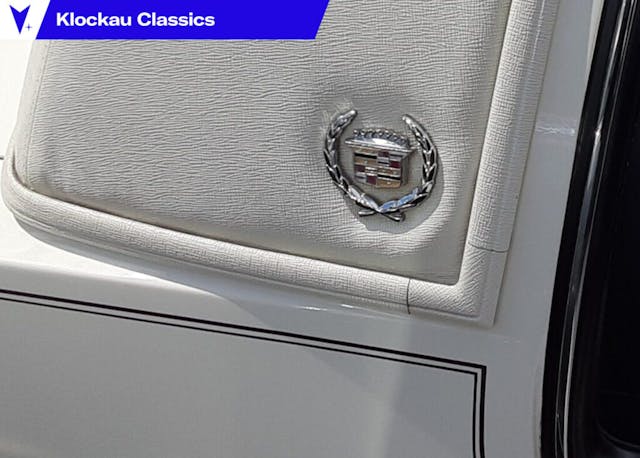
As is frequently the case, my primary goal in writing these random scribblings is reintroducing cars to folks like you all. Sure, I’ve done Mustangs and Camaros and more, well, mainstream vintage motor vehicles, but I always—and frequently!—come back to my favorites. And those favorites are generally cars that you don’t see at shows or haven’t seen on the city streets and country highways in 30 years. Like today.
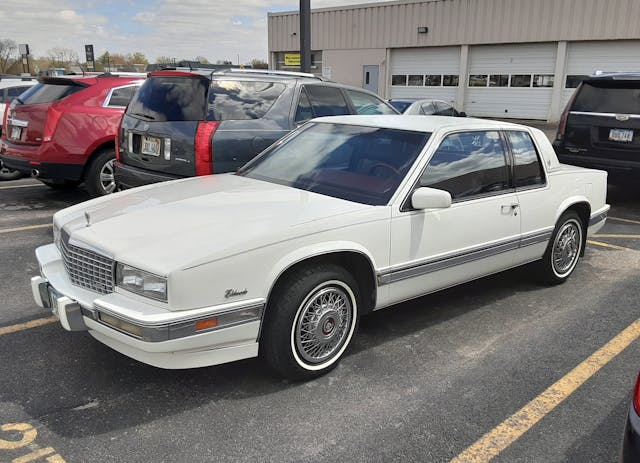
Cadillac. Once a purveyor of sumptuous, V-8-powered dreamboats like the 1967 Coupe de Ville, 1958 Eldorado Biarritz, and other grand, large-and-in-charge luxocruisers, today alternates between gonzo V-8 sedans like the CT5-V, huge SUVs like the popular Escalade, and more mainstream crossovers like the XT5. But the big sellers are those aforementioned crossovers. I prefer sedans. Apparently I am in the minority, sadly. But I miss the old days when you could walk into a Cadillac dealer and drive out in a brand new Sedan de Ville or Sixty Special. And when cars were cars! Coupes, sedans, convertibles.
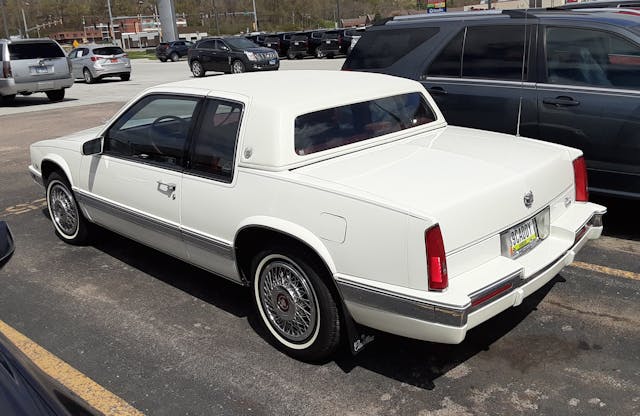
Even in 1989, nary a crossover or 4×4 was to be seen in the fancy-schmancy, deluxe, 82-page Cadillac brochure. But you had a newly-redesigned and elongated Fleetwood, Coupe de Ville, and Sedan de Ville, the swoopy Allante convertible, and, of course, the Seville and Eldorado. None came with all-wheel drive, a roof rack, or step plates. Heaven forbid!

Cadillac spent most of the ’80s slimming down its cars. The Fleetwood and de Villes got it in 1985 (though introduced early in ’84), then the Seville and Eldorado shrunk—too much, by most accounts—in 1986. The Allante appeared in 1987 to enhance Cadillac’s luxury image with a two-seat convertible (and with removable hardtop, like the Mercedes-Benz 560SL). The Cimarron had been cancelled (and yes, I shall be writing up one of those someday), and Cadillac commercials and advertising included the memorable “Cadillac Style” series of commercials.
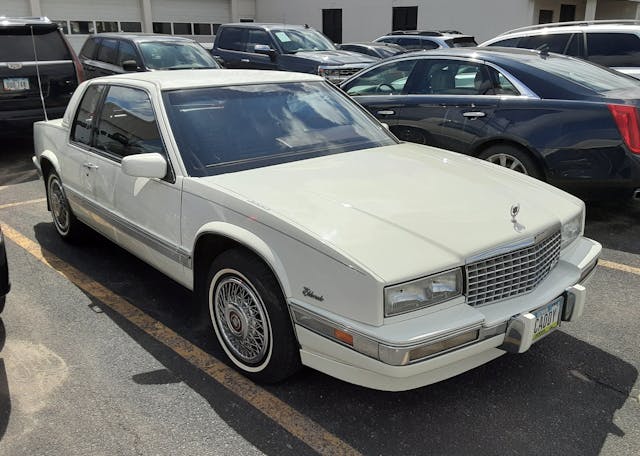
At the time, I was a nine-year-old kid, but I loved Cadillacs and Lincolns, and if I was waltzing through the living room on various missions and a Cadillac commercial was playing on TV, I always had to stop and watch until it ended. Yes, ladies and germs, I was Brougham-smitten even back then.
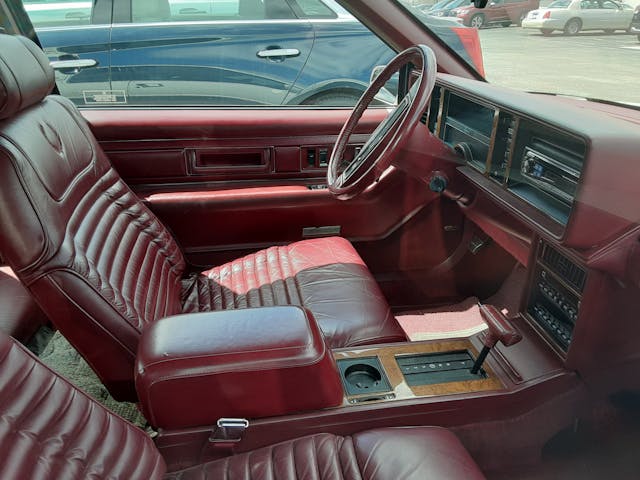
So I loved the Eldorado, even though between 1985 and ’86 it had drastically shrunk. While the newly downsized, newly front-wheel-drive de Villes and Fleetwoods (with the exception of the RWD Fleetwood Brougham/Brougham/Brougham d’Elegance, which retained its 1980-style body) sold very well, the 1986–87 Eldo and Seville saw a rapid decline in sales.

How so? In 1985, 74,101 coupes and 2300 Biarritz convertibles were sold. Now, granted, people knew the car was shrinking for ’86 and bought accordingly, but in 1986 sales were 21,342; all were coupes. Now, that’s a catastrophic drop by most anyone’s standards. I like them now, but even back then I thought, “Why did they make them so much smaller?” The following year was even worse: only 17,775.

They weren’t really SO much smaller, but visually they looked pretty truncated compared to the very pretty 1979–85 Eldos. A 1985 Eldorado was 204.5 inches long with a 114-inch wheelbase, the ’86 was 188.2 inches long with a 108-inch span. Yes, that was a reduction by anyone’s standards, but the problem was the proportions were more skewed than the reductions reflected. It had a short little rear overhang, flush taillight lenses and the C-pillar was a whisper of the fat, regal sail panel on the earlier model. What to do?
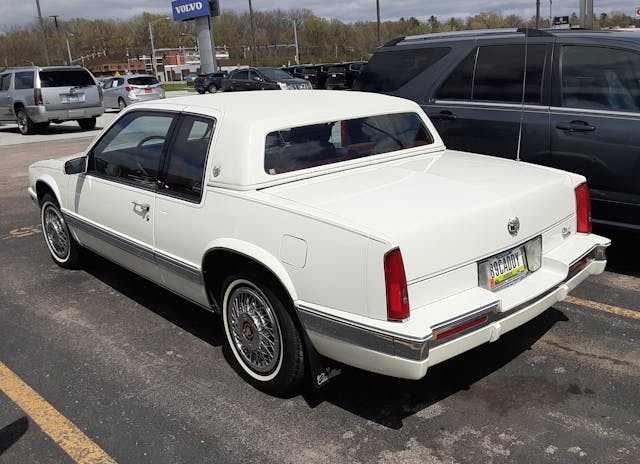
Well, they couldn’t very well bring back the old model, so the decision was made for a quick and dirty stretch. The basic car remained, but the front fenders and hood were stretched, with a slight blade to the fender tips, and the taillights bumped out past the trunk panel, resulting in little finlets that also lengthened the car and gave it a more Cadillac look.

Even better, the rather (ahem) sedate 4.1-liter V-8 was redone and became the much more powerful, more robust 4.5-liter V-8. Sales rebounded to 33,210 for 1988. In 1989, the year of our featured example, a total of 20,633 Eldorados and 7174 Eldorado Biarritzes were sold.
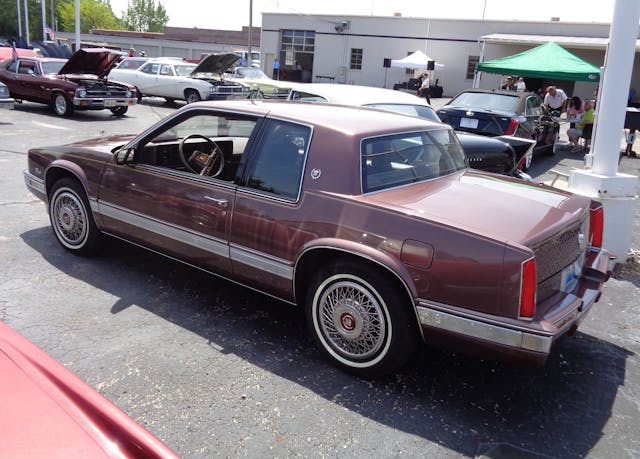
Base price for an ’89 Eldo was $26,915. Power was 155 horsepower at 4000 rpm with 240 lb-ft of torque at 2800 rpm. As the brochure extolled, “The 1989 Eldorado is for those discerning individuals who insist on the finest in personal luxury coupes. Those who want bold, standout styling. Assertive 4.5 V-8 power. Four-wheel power disc brakes. Abundant personal amenities. And sophisticated technology.”

Back in 1999, I test drove a ruby red ’89 Eldorado with matching red leather, in nearly as nice condition as this Cotillion White example, and just loved it. Smooth, fast, plenty of get up and go.
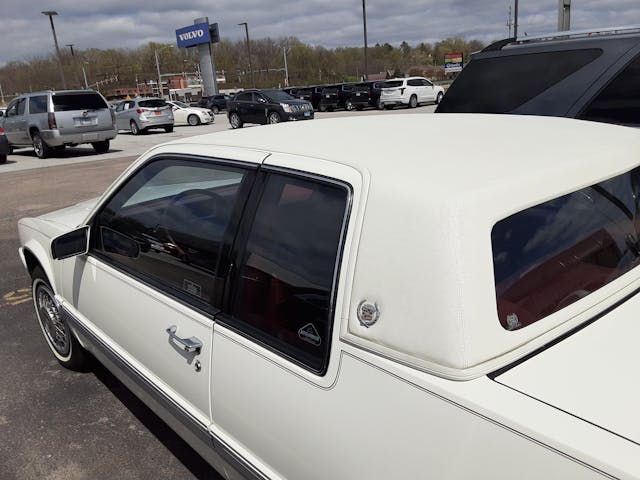
I remember sunset was approaching and a little message appeared below the digital gauges: Headlamps Suggested. Yep, it was a smart car well before Mercedes introduced its two-seat mini-commuter. I loved the car, but I was a freshman in college and really, REALLY didn’t need a second car at the time. But I still remember that car fondly, 24 years later. It was really nice.

I spotted our featured car (the white one; the Rosewood one is owned by a Chicagoland friend, Frank Murphy, and was seen at the 2017 Shirey Cadillac show) at the local Cadillac dealer back in April 2021. I was immediately smitten. The car was in remarkably tidy original condition, with the rather seldom seen full vinyl roof, resplendent in Cotillion White with a red leather interior. Alas, it was not for sale, but was merely in for service. Well, it’s just as well; I’d have had to rent a garage to store it safety from the elements that she’d deserve.
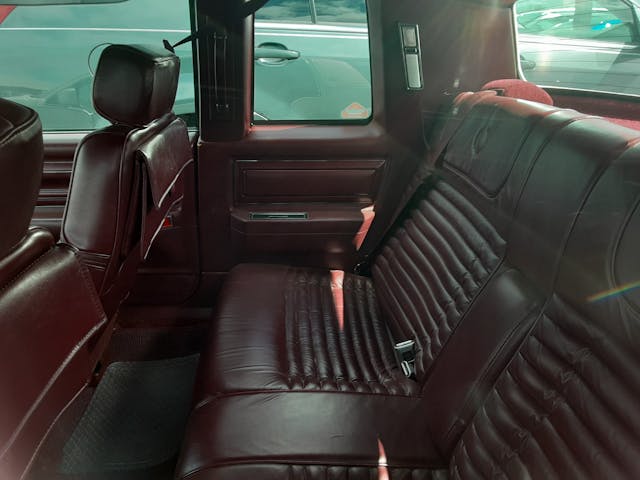
In 1992, the Eldorado was totally restyled—and very pretty! But 1991 was the end for a lot of things on Eldorados that had been available for decades: factory vinyl roof, factory-available wire wheel covers, the Biarritz model with half-top, button-tufted upholstery, electroluminescent opera lamps, fender-mounted lamp monitors, and the like. A lot of people—most people—have forgotten these cars, but I have always and will always love them. They are wonderful to drive!
***
Check out the Hagerty Media homepage so you don’t miss a single story, or better yet, bookmark it. To get our best stories delivered right to your inbox, subscribe to our newsletters.


Shocking article considering the source. Arguably one of the worst cars of the decade that is only interesting to future generations that don’t know any better.
One of the worst cars of the decade? Really.
“Arguably” being the operative term here.
I leased a 1985 Eldo from 85 to 87. It was OK except for fading paint. I mean just OK, nothing spectacular other than the half padded and stainless roof. I remember leaving the car at Cadillac and seeing Cars coming in with the hated 8-6-4 engines that people hated. I talked with a few folks and was glad I didn’t have one.
Great profile, Tom. What you said at the end about the certain options having disappeared with the introduction of the redesigned ’92 models lends some finality to the featured car and ones like it. Also, and to your point, the 16″ shortening of the ’86 compared to the ’85 appears much more drastic than this number would suggest.
My very first Cadillac was the 1989 Cadillac Seville. It had me under it’s spell from the very beginning, because I had always wanted to own a new Cadillac, so when I saw this black, or should I say SABLE BLACK, on the showroom floor at Bob Moore Cadillac in downtown Oklahoma City, I immediately knew I had to have it, especially since it had the GOLD PACKAGE, which included the wire rims and the Vogue Tyres and the simulated convertible top the gold plating all over. Without exception, that Seville was the most beautiful Cadillac I had ever seen, with the beautiful black leather interior and the gold-plated wire rims. Simply stated, it was a beautiful piece of Heaven on wheels! #CADILLAC MEMORIES ARE FOREVER THE AMERICAN DREAM!
I don’t know what rock you’ve been hiding under, but 89 Cadillac El Dorado was the worst El Dorado ever produced. A gem? You joking right?
Everyone I knew with one loved it, it also had a good engine, which was lacking in 82-87
Certainly no worse in most ways than the bloated 1977-78 models, which weren’t even redeemed by an available convertible model.
‘Now, granted, people knew the car was shrinking for ’86 and bought accordingly, but in 1986 sales were 21,342; all were coupes. Now, that’s a catastrophic drop by most anyone’s standards’
Not only the shrinkage, but the 85-87 Olds Calais two door looked vastly similar for half the price. Profile, proportions [a little more awkward on the N Body, yes] roofline, long hood, squared wheel openings, bright side trim between the wheels, vertical tail lights, license plate shadow box.
Sort of like the 92 Seville looked like a five door Chevrolet Corsica: all the visual points were the same: profile, roofline, tail lights, boring grille.
Great piece. Yes, I love em. The perfect size
Mom and Dad had an 87 Coupe DeVille in that cranberry red metallic and white vinyl top. White leather. Looked very much like this 89 Eldorado.
“…much more powerful, more robust 4.5-liter V-8… Power was 155 horsepower at 4000 rpm with 240 lb-ft of torque”
Even more shocking is that a few years later in 1994 power had nearly doubled with the introduction of the Northstar, yet displacement was just 100 ml larger. I owned a 1997 STS and _that_ was a fun car.
Did they have the hook and tow motor? HT 4100.
I worked at a Cadillac dealership from 1984-1994. The early ’80’s were grim times for Cadillac and GM but things started improving by the late 80’s. The 4.5 V8 was came out in 1988 and by 1989, they figured out how to seal dissimilar metals with a new intake manifold gasket and fasteners. You could update the old HT 4100 engines with the new gaskets and fasteners and they would last forever. All of the problems with camshafts and main bearings wearing out were due to coolant getting in the oil from the intake gaskets leaking. I had many vehicles where you could remove the intake manifold bolts with your fingers because the gaskets had compressed between the iron head and aluminum intake. The gaskets usually didn’t leak enough to cause a milkshake in the oil. They leaked just enough to compromise the quality of the oil. The 4.1 and early 4.5 V8’s had a bad reputation from a major flaw that was finally fixed in 1989. It’s too bad it took seven years for the engineers to figure it out.
This is the period of cars I grew up with as a kid but don’t recall any fond memories of. I much preferred the Lincoln Mark VII over this as a kid.
I liked these, but would prefer the 1991 with the more powerful engine. The Riviera for 1989-91 was also quite an attractive car, after being shrunken and rather homely for 1986-88.
GM made a big mistake going all corporate chassis in this era. They tried to fix the Cadillac by making them longer but it still did not fix the real issues.
I know these cars still have fans but the history is there and hard to ignore. Cadillac really lost their mojo and just never did recover fully.
Putting these names on the wrong cars is very damaging to the brand and the models. All the name equity was destroyed for a full generation.
This is why I warn about using Corvette on things that are not 2 seat sports cars. Not a purist here but a badly marketed SUV could do major name damage that could take years to fix.
They could minimize the risk calling the SUV a Nomad and say it was tuned by team Corvette.
Bean-counters doomed the Detroit domestics through the 1970’s and 1980’s, and nothing has been able to win back drivers under say 50 years of age. As emissions regulations came (thankfully) to be in the late 1960’s, at the volume they produced, it was criminal for GM, Ford and Chrysler not to develop in-house fuel-injection systems. Carburetors and throttle-body fuel injection made so many Detroit-cars miserable to live with through the late 1970’s and 1980’s. The Ford 302-Windsor of 1986 was the first mass-market Detroit engine to apply real fuel-injection and roller-camshafts / rockers that I can recall. It made these engines so much better than their competitors. This is when Lincoln really started to blow past Cadillac in their sales. The HT-4100 and their successors were as reliable as the first Vega 4-bangers; both preposterous designs that never would have been allowed in their German and Japanese competition. The Detroit insistence on crappy 4-cylinder engines, worst at GM, drove generations of buyers to Japanese competitors, and they have never returned. Ninety-degree V-6’s built from V-8’s are another example.
All of the Cadillacs of these era’s were basically nice cars, but could not get past 50,000 miles in many instances. It’s why they are so cheap to buy today.
I have a 100,000 mile Northstar Sedan DeVille purchased from an estate in my garage. I drive it, but can’t give it to my kids, because they don’t want to add oil and coolant every Sunday.
You can’t have a world-leading economy based on importing complex manufactured items. But the Big Three did more than their part to put us here. That’s why Congress is debating the debt ceiling as we speak. Few ask why.
That’s why I’m glad that Mary Bara is running gm now, because the stupid men were ruining the corporation. Starting with Roger B. Smith.
If the men would have still been in control of gm the Corvettes would have still been front engine and rear wheel drive.